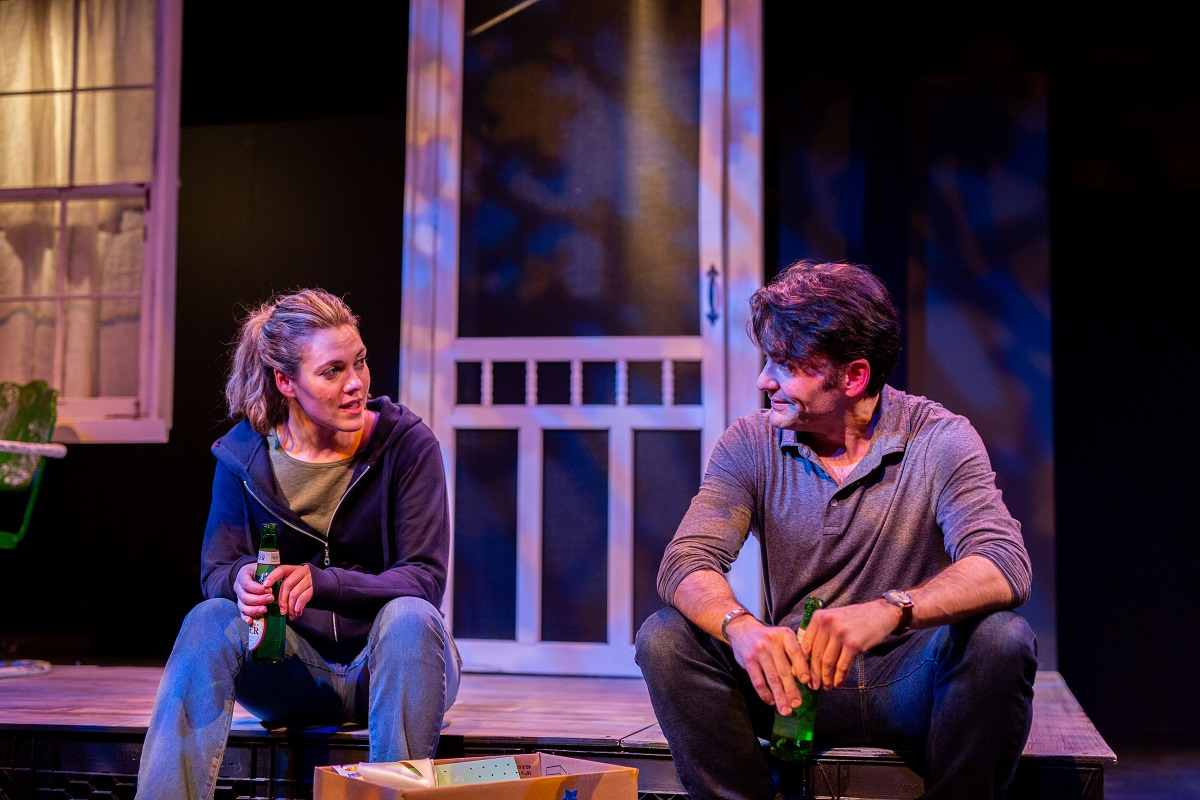
Chasing the River
Written by Jean Dobie Giebel
Directed by Ella Jane New
Presented at the Chain Theatre
February 7-29, 2020
The title of Jean Dobie Giebel's play Chasing the River, making its world premiere as a production of the Chain Theatre, alludes to the act in poker of staying in the game against the odds until the final card is dealt in hopes of hitting a hand such as a flush or straight. However, given the play's concern with the past, and especially its traumas, the title also evokes the fruitlessness of trying to capture, or recapture, something that is always changing and always moving forward. How, the play asks, does one chase that winning hand when the effects of abuse make it a struggle to simply stay in the game?
Chasing the River introduces us to Kat (Christina Elise Perry). Most recently, Kat has been living in Philadelphia. Prior to Philadelphia, Kat was living in prison. And before prison, Kat lived in the small Pennsylvania town to which she has just returned when the play opens, a return occasioned by the need to deal with her family home now that her aunt, poker-aficionado Adelaide (Sara Thigpen), is no longer living. Kat's return brings her face to face with her high-school boyfriend, Sam (David Rey), who has remained in the town and taken over his father's small business, and her mother, Maggie (Robyne Parrish), who took Kat's younger sister, Beth (Caroline Orlando), but not Kat with her when she left their father and with whom Kat's relationship remains strained. Aside from these flesh-and-blood figures of bygone days, however, Kat is also confronted with the memories that are inextricable from the place, both of her beloved aunt Addie and, more painfully, those involving her abusive, alcoholic father, Nate (David Wenzel). In this unenviable position, the central question is whether Kat can -- or even wants to -- fashion from her fraught homecoming a true second chance in order not to be borne back ceaselessly into the past.
The play interweaves Kat's memories with the present action not only through flashback scenes but also through the occasional ghost-like intrusion of characters or recorded voices into scenes set in the present. The non-linear progress of the narrative thought-provokingly evolves and complicates the audience's perspectives on characters and events. For example, Kat making the varsity high-school basketball squad as a freshman takes on slightly different cast when we learn later of her father's deep disappointment that neither of his children was a son. (A potential parallel also emerges between the way that the other players dislike Kat for being so good and the animosity that greets abuse or assault survivors who come forward.) Similarly, a scene of genuine happiness, brilliantly performed by Perry and Wenzel, in which Kat's face shines with love as she looks on a father who, overflowing with excitement, completely and sincerely believes, in the moment, his own promises of the most fun summer ever, cannot help but be heartbreaking because of everything else that we know. The characters themselves have clashing perspectives regarding both the events of the past and the shape of the future, on who was protecting whom, on what help looks like and on how and when one asks for it. The play highlights the guilt and misplaced blame that often accompany abuse and assault, the lack of understanding why someone didn't speak up or "just" leave, the way that abuse becomes a pattern passed from one generation to the next, and the way that suffering abuse leads women to prison -- a site of punishment rather than healing -- instead of to aid.
The production is staged on and around a minimalist front porch with a couple of weathered metal chairs, a window, and a screen door in a mix of verisimilitude and suggestion that pairs well with the play's mix of memory and presence. While the entire cast brings an affecting emotional heft to their performances, Perry is particularly powerful, communicating so much with just Kat's body language: her closed-off wariness, for instance, is expressed in how much time she spends with her hands jammed in her hoodie pockets or pulling its sleeves down over her hands, or how she zips back into it like armor after one particular disappointment. Rey and Orlando both render relationships with Kat that feel authentically lived-in, and Rey not only lends Sam a sometimes thorny complexity but is also responsible for some of the funniest of the play's flashes of levity (although Orlando's small-child imitation is also pretty hilariously spot-on).
Kat's very name functions as a symbol of potential self-determination. Others variously call her Katie, Katydid, and Chickadee, but Kat is the only name that she chose for herself (albeit when she went to prison). With the struggles of Kat and those around her, Chasing the River takes a plunge into the legacy of trauma and the possibilities that exist as long as one has, to paraphrase Adelaide, a single chip and a seat at the table. - Leah Richards & John Ziegler
